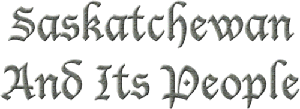
THE LISTER KAYE FARMS.
The Bell Farm at Indian Head still stands we believe as the
biggest
stretch of continuous country ever intended to be a farm-not a cattle or
sheep range, but an actual farm. The Lister Kaye farm project is also,
we believe, the biggest project of its kind that ever was~planned. It com-
prised 100,000 acres bought from the government and the C. P. R. and
eighty thousand acres from the Powder River Ranch Co. situated between
Mosquito Creek and the Little Bow River, but they were spread over a
line of country hundreds of miles long in sections of ten thousand acres.
This gigantic scheme was fore-doomed to failure from its inception, and
Sir John Lister Kaye was duly warned that it would be so; but the York-
shire Baronet proceeded with the scheme which ran to its inevitable end.
The scheme was, briefly, to establish farms, and sell them ready broken
and stocked to settlers, presumably from England. At that time it was
almost an axiom that wheat could not be grown successfully more than
about thirty miles west of Moose Jaw. At that point one struck a country
marked on the early maps as "semi-arid." It was recognised as one of
the best stock countries in the world, but it was said there was an insuffi-
ciency of moisture at the time most needed for growing crops. Mr. D. J:
Wiley, who lived in the heart of this country, had an interview with Sir
John in London, and gave him a straight opinion on the idea of growing
wheat in this semi-arid belt. Sir John was a little nettled at any kind of
cold water being thrown on his magnificent scheme. Mr. Wiley said the
stock end of the plan was alright, but Sir John would have it that the
scheme as a whole was sound. He went ahead, with one rather humiliat-
ing result, viz.: that he is remembered principally in the West as the man
who tried to nourish his wheat with the aid of water carts.
Another thing fatal to the scheme was that people could not be expected
to pay cash for land, when there were millions of acres of land equally as
good, which could be obtained for nothing, or next to nothing from the
Government, for 160 acres could be obtained for a ten dollar fee, and
another 160 as a "pre-emption" for two dollars and a half an acre. Even
if the farms had been situated in the well watered district of Eastern
Assiniboia, or the district of Saskatchewan, it would have been, under the
most favorable circumstances, ahead of its time.
About the.first the farming community knew of the Lister Kaye enter-
prise was an announcement in 1887 that a wealthy Yorkshire Baronet
had bought 7,000 acres at Balgonie, was erecting a building 130 feet long;
had thirty ploughs breaking, under the management of Mr. W. Blackburn,
who was described as a "most urbane and energetic representative." This
was intended to be a kind of home farm and a base of supplies In 1888
Bibliography follows:
|
|
Previous Page 

 Next Page Next Page
THE STORY
OF
SASKATCHEWAN
AND ITS PEOPLE
By JOHN HAWKES
Legislative Librarian
Volume II
Illustrated
CHICAGO - REGINA
THE S.J. CLARKE PUBLISHING COMPANY
1924
| |
|
Visitor #
Web Master: Sask Gen Webmaster,
for Sask Gen Web Project
Re-published ©:
URL:

We encourage links to this page.
These electronic pages may NOT be reproduced in any format
for profit or presentation by any other organization or persons.
Persons or organizations desiring to use this material, must
obtain the written consent of the contributor, or the legal
representative of the submitter, and contact the listed Web
master with proof of this consent.
| |
|

